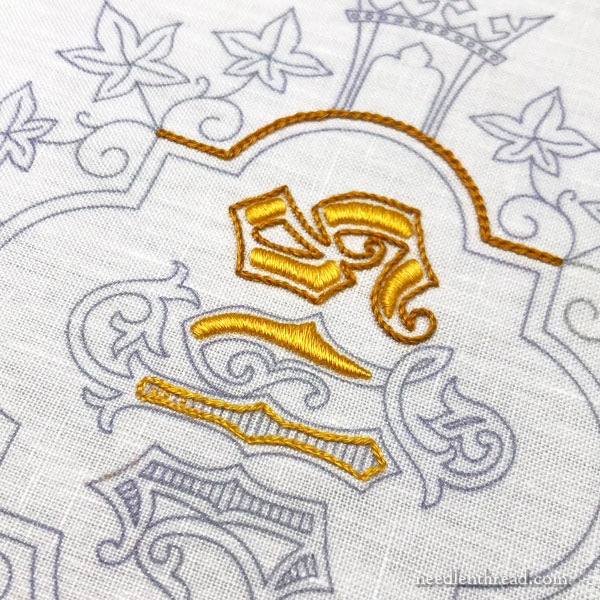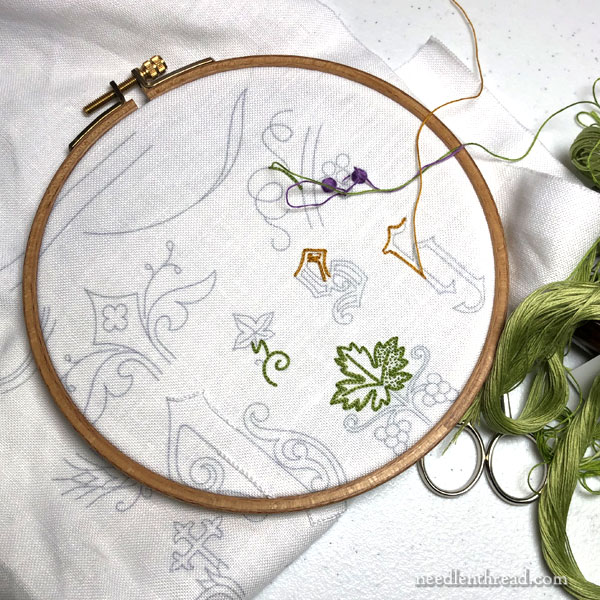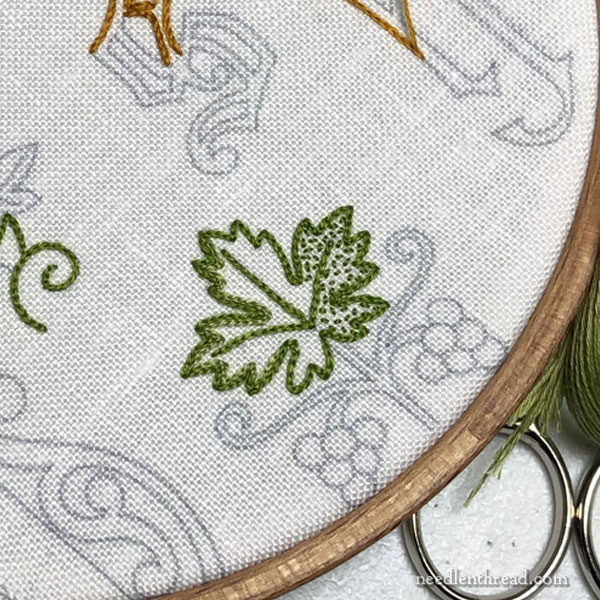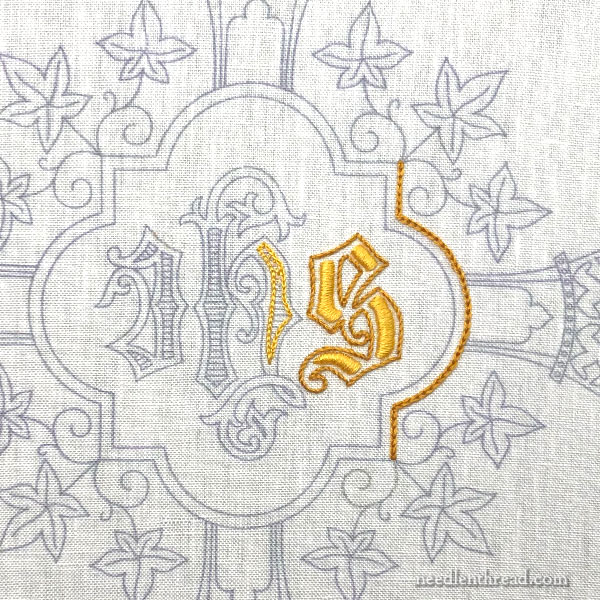Recently, I was asked if I would teach a local class on ecclesiastical embroidery – specifically, how to make what is called a pall.
Things being what they are, the preparations were a little rocky. And I haven’t progressed as far as I’d like in my sample project for such a class.
And in fact, I’m not sold on my sample project, as little as it has progressed!
But I’m going to show it to you anyway and share some thought processes…

To keep the long story short, I’ll explain what a pall is. I’ve talked about palls before here on Needle ‘n Thread, because I’ve embroidered many, and I’ll link to some of those articles below.
Essentially, it’s a linen square that covers the chalice during Mass.
Different churches have their preferences for size, style, decoration, and so forth, but in the Catholic Church (and also in the Anglican), the one “rule” for a pall is that the fabric that touches the chalice must be linen.
Today, the pall is usually stiff, so it is made up into a sort of pocket and then a thin board is inserted inside the pocket. The pocket is stitched closed so that it tightly hugs around the thin board. Sometimes, there’s a decorative edging on the pall, made of fine lace, needle lace, tatting, or something similar.
The size of the finished pall varies, but an average size is about 6-7″. I make mine 6.25″.
The design I’m using on this particular pall is found in my Church Patterns e-book.
When I started gathering ideas for the class, I pulled together a dozen patterns to give the participants a range of designs to choose from. The designs ranged from simple to complex, as I didn’t know what level of stitchers would be involved in the class. This design falls in the middle range – it’s not simple, but it’s not as complex as a couple of the others.

I put together a kind of doodle cloth – or sampler cloth – so that I could try out various threads and stitches on different elements that I extracted from the designs.
I figured this would be a good thing to give to the class participants, so that they also could test stitches, threads, and ideas before they actually worked on the design itself.
To test threads, I pulled out cotton embroidery threads only, and specifically, floche, regular DMC stranded cotton, and coton a broder whitework threads. (You can read about floche here if you’re not familiar with it, and you can read about coton a broder here if you’re not familiar with it. And you can see the two threads compared and read about their differences here.)
Palls are often embroidered white-on-white, so I wanted to test three weights of coton a broder: 20, 25, and 30. These are the weights commonly available today (you can find them through shops like Lacis, online).
Normally, I would stitch a pall in silk. But with beginners, I figured that cotton would be a better start.
To make a sample project that’s a little more visually accessible, I decided to work my sample project in color. And to do this, I settled on floche over regular DMC stranded cotton.

One thing that I love, love, love about floche is that it makes such a pretty split stitch. There are few times that split stitch plays a starring role (unless it’s in Opus Anglicanum!), but when you’re using floche, split stitch makes a lovely filling and a lovely line stitch for visible lines.
You can see an example of split stitch as a filling with this embroidered monogram. It works well!
The green leaf above is split stitched around the edge, and then I tried some seed stitch on one side and on the other, I tested another line of lighter green split stitch inside the main outline.

The trouble I’m having here, in my head, is that, as much as I love floche, it is relatively heavy compared to, say, one strand of DMC stranded cotton (one strand taken from the six).
And with this design, being somewhat busy, the floche might be a bit much.
I haven’t decided absolutely on this.
Floche makes such a beautiful satin stitch. And it’s a lovely thread to work with. But in the end, will I find the finished embroidery too chunky for the design?
I ponder this.
But I think I’m going to keep moving forward, anyway. If nothing else, it will make a good sample for future classes.
So that’s another project I have going. I’m not 100% sold on it, but it might grow on me!
On the home front, mom is still in the hospital. I have no idea how things will work out in that direction, either.
In the meantime, have a wonderful weekend and hopefully, next week, I’ll be back to a more regular schedule!
Read More About Palls
Ecclesiastical Embroidery: Pall Design (grapes, IHS pall design)
Finishing Work on Hand Embroidered Pall – the small red cross
Cross & Lily Pall Pattern
Simple Stitches for Beautiful Results on a Whitework Pall
Adding Texture with Seed Stitch on a whitework pall